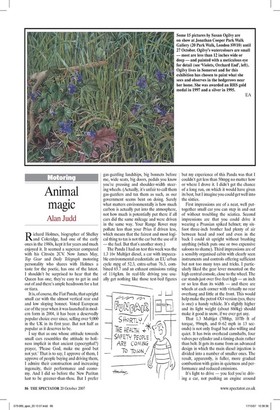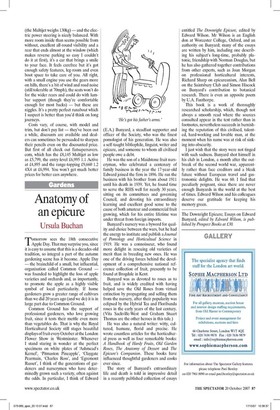Animal magic
Alan Judd Richard Holmes, biographer of Shelley and Coleridge, had one of the early ones in the 1980s, kept it for years and much enjoyed it. It seemed a supercar compared with his Citroen 2CV. Now James May, Top Gear and Daily Telegraph motoring personality who shares with Holmes a taste for the poetic, has one of the latest. I shouldn't be surprised to hear that the Queen has one; they're easy to get in and out of and there's ample headroom for a hat or tiara.
It is, of course, the Fiat Panda, that upright small car with the almost vertical rear end and low sloping bonnet. Voted European car of the year when it was launched in modern form in 2004, it has been a deservedly popular choice ever since, selling over 9,000 in the UK in its first year. But not half as popular as it deserves to be.
I say that as one whose attitude towards small cars resembles the attitude to holiness implicit in that ancient (apocryphal?) prayer, 'Please God, make me good but not yet.' That is to say, I approve of them, I approve of people buying and driving them, I admire their construction and increasing ingenuity, their performance and economy. And I did so before the New Puritan lust to be greener-than-thou. But I prefer gas-guzzling landships, big bonnets before me, wide seats, big doors, pedals you know you're pressing and shoulder-width steering wheels. (Actually, it's unfair to call them gas-guzzlers and tax them as such, as our government seems bent on doing. Surely what matters environmentally is how much carbon is actually put into the atmosphere, not how much is potentially put there if all cars did the same mileage and were driven in the same way. Your Range Rover may pollute less than your Prius if driven less, which means that the fairest and most logical thing to tax is not the car but the use of it — the fuel. But that's another story.) The Panda I had on test this week was the 1.3 16v Multijet diesel, a car with impeccable environmental credentials: an EU urban cycle mpg of 52.3, extra-urban 76.3, combined 65.7 and an exhaust emissions rating of 114g/km. In real-life driving you usually get nothing like those test-bed figures but my experience of this Panda was that I couldn't get less than 50mpg no matter how or where I drove it. I didn't get the chance of a long run, on which it would have given its best, but I imagine you could get well into the sixties.
First impressions are of a neat, well puttogether small car you can step in and out of without troubling the sciatica. Second impressions are that you could drive it wearing a Prussian spiked helmet; my sixfoot three-inch brother had plenty of air between head and roof and even in the back I could sit upright without brushing anything (which puts one or two expensive saloons to shame). Third impressions are of a sensibly organised cabin with clearly seen instruments and controls offering sufficient but not too many toys and tricks. I particularly liked the gear lever mounted on the high central console, close to the wheel. The car stands just over five-feet high — an inch or so less than its width — and there are wheels at each corner with virtually no rear overhang and little at the front. This would help make the petrol 4X4 version (yes, there is one) a handy vehicle. It's slightly higher and its light weight (about 860kg) should make it good in snow, if we ever get any.
That 1.3 Multijet (70bhp, 1071b ft of torque, 99mph, and 0-62 mph in 13 seconds) is not only frugal but also willing and quiet. It has twin overhead camshafts, four valves per cylinder and a timing chain rather than belt. It gets its name from an advanced design in which the main diesel injection is divided into a number of smaller ones. The result, apparently, is fuller, more gradual combustion with gains in quietness and performance and reduced emissions.
It's light to drive — you feel you're driving a car, not pushing an engine around (the Multijet weighs 130kg) — and the electric power steering is nicely balanced. With more room inside than seems possible from without, excellent all-round visibility and a rear that ends almost at the window (which makes reverse parking so easy I couldn't do it at first), it's a car that brings a smile to your face. It feels carefree but it's got enough safety features, leg-room and even boot space to take care of you. All right, with a small engine you use the gears more on hills, there's a bit of wind and road noise (still tolerable at 70mph), the seats won't do for the wider rears and could do with lumbar support (though they're comfortable enough for most backs) — but these are niggles. It's a pretty perfect runabout which I suspect is better than you'd think on long journeys.
Costs vary, of course, with model and trim, but don't pay list — they've been out a while, discounts are available and dealers can sometimes be persuaded to sharpen their pencils even on the discounted price. But first of all check out fiatsupersavers. com, which has the £8,145 Multijet as low as £5,799, the entry-level £6,995 1.1 Active at £4,895 and the range-topping £9,660 1.2 4X4 at £6,994. You won't get much better prices for better cars anywhere.








































































 Previous page
Previous page